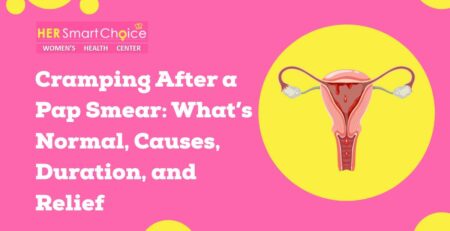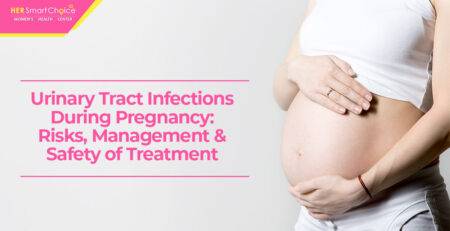Permanent Birth Control: Understanding Tubal Ligation

Considering permanent birth control? At Her Smart Choice, we guide women through safe, long-term options like tubal ligation – a trusted procedure chosen by over 700,000 women in the U.S. each year. This surgical method of female sterilization works by blocking or removing your fallopian tubes, giving you lasting freedom from unintended pregnancies. This guide dives deep into how it works, its success rates, potential risks, what to expect during recovery, and your options for future fertility. Whether you’re exploring laparoscopic tubal ligation at a women’s health center or comparing birth control options with salpingectomy for ovarian cancer risk reduction, you’ll find clear insights here, organized by topic:
Follow Us!
- What tubal ligation involves and how it prevents pregnancy
- How effective it is, what happens if it fails, and factors like age
- The risks, benefits, and long-term outlook, including salpingectomy
- Your recovery journey, managing pain, and post-procedure care
- Options for getting pregnant after tubal ligation, including reversal and IVF
- How to make the right choice for you and what other options exist
- Answers to common questions and patient concerns
What Is Tubal Ligation and How Does It Work?
Tubal ligation is a surgical procedure that permanently closes, clips, or removes your fallopian tubes. This stops eggs from reaching sperm, making natural conception impossible. This one-time, non-hormonal procedure blocks the path from your ovaries to your uterus — and is over 99% effective at preventing pregnancy. Most procedures are done using laparoscopy or a mini-laparotomy, with either general or regional anesthesia. During laparoscopy, tiny incisions allow a camera and instruments to place loops, clips, or use heat to seal the tubes, or even remove a section. After the procedure, you’ll get instructions on caring for your incisions, any activity limits, and what signs to watch out for.
What Is Tubal Ligation and Female Sterilization?
Female sterilization refers to permanent birth control methods that prevent fertility by targeting the fallopian tubes. Tubal ligation includes various techniques like using clips, rings, heat, or removing part of the tubes. Bilateral salpingectomy, which involves completely removing both tubes, is a type of sterilization that also helps lower your risk of ovarian cancer and is increasingly recommended by leading medical experts.
Trends and Perceptions of Female Sterilization in the United States Female sterilization, including tubal ligation, is a leading method of contraception among women in the United States, with millions of women relying on it for permanent birth control. According to the National Center for Health Statistics, tubal ligation remains one of the most common birth control choices among women who have completed their families. While its effectiveness is well-established (over 99%), research in the U.S. often focuses on factors influencing the decision, patient satisfaction, and the importance of comprehensive counseling to address potential regret. Studies indicate that women choose sterilization for various reasons, including a desire for highly effective, non-hormonal contraception and the completion of childbearing. Healthcare providers play a critical role in ensuring women are fully informed about all contraceptive options, including the permanent nature and potential for regret associated with sterilization, to support autonomous decision-making. Source: Synthesized from data and research by the Centers for Disease Control and Prevention (CDC) and the Guttmacher Institute on contraceptive use in the U.S.
How Does Tubal Ligation Prevent Pregnancy?
The procedure creates a physical barrier in your fallopian tubes, preventing an egg released from your ovary from traveling to your uterus. By sealing, cutting, or removing a section of the tube, the egg and sperm can’t meet, thus blocking fertilization. If you have a salpingectomy, the entire tube is removed, providing permanent contraception without affecting your hormone levels or ovarian function.
What Are the Different Methods of Tubal Ligation?

Before choosing a method, you and your doctor will discuss surgical risks, the possibility of reversal, and long-term results.
| Method | How It Works | Key Benefit |
|---|---|---|
| Pomeroy Loop | Ties and cuts a section of the tube | Proven safety record |
| Filshie or Hulka Clips | Uses a small clip to pinch the tube shut | Can sometimes be reversed |
| Fimbrioplasty & Rings | Uses heat and a silicone ring to close the tube | Minimally invasive |
| Bipolar Cautery | Seals the tube with electrical heat | No foreign material left behind |
| Partial or Complete Removal | Surgically removes part or all of the tube | Lowers ovarian cancer risk (salpingectomy) |
All these methods offer permanent birth control, but they differ in how invasive they are, whether they can be reversed, and how they affect nearby structures. The best choice for you depends on your personal priorities and health.
How Does Laparoscopic Tubal Ligation Differ from Other Methods?
Laparoscopic tubal ligation uses a small camera and tiny incisions to access your abdomen. This usually means a quicker recovery, less pain afterward, and a lower risk of infection compared to a mini-laparotomy. This less invasive approach allows for better views of your pelvic organs, precise placement of closing devices, and shorter hospital stays, often less than 24 hours. Recovery typically involves minimal scarring and a faster return to your usual activities.
How Effective Is Tubal Ligation as Permanent Birth Control?
Yes, tubal ligation is one of the most reliable forms of birth control available, with success rates over 99% when done correctly. Failures are usually due to the tubes not being fully closed, reconnecting on their own, or a rare instance of a device moving.
Fewer than 1 in 200 women become pregnant after ligation over ten years, though some long-term studies show a cumulative pregnancy rate of up to 3–5%. If pregnancy does happen, about 25% of those are ectopic pregnancies, so it’s vital to know the warning signs.
What Is the Tubal Ligation Effectiveness Rate?
Long-term studies show that methods using clips or rings have a failure rate of less than 1% in the first year and under 2% over a decade. This makes tubal ligation more effective in real-world use than birth control pills or condoms.
Can You Get Pregnant After Tubal Ligation?
While rare, pregnancy can occur if a small opening forms in the tube, a clip moves, or the sealing wasn’t complete. These issues usually show up within the first two years after the procedure and might need further medical evaluation. Noticing unusual bleeding or pain early can help speed up diagnosis.
What Is the Risk of Ectopic Pregnancy After Tubal Ligation?
The risk of an ectopic pregnancy increases because if fertilization does happen, it occurs in a damaged or partially blocked tube. Symptoms can include sharp pain in the lower abdomen, shoulder discomfort, and vaginal bleeding. It’s crucial to seek immediate medical help, as ectopic pregnancies are a serious health risk.
How Does Age Affect Tubal Ligation Success?
Women under 30 might have slightly higher failure rates, possibly because the closure methods have a longer time to potentially fail and their bodies heal more robustly, which could lead to rejoining. On the other hand, women over 35 often see the highest effectiveness. Discussing age-related outcomes helps set realistic expectations.
What Are the Risks and Benefits of Tubal Ligation?
Tubal ligation offers a high success rate but also comes with surgical and long-term considerations. Weighing potential risks like reactions to anesthesia, bleeding, or infection against the benefit of permanent, non-hormonal birth control helps you make an informed choice.
Right after surgery, risks include complications like accidental damage to nearby organs. Over time, the benefits include freedom from daily birth control worries and a potential decrease in ovarian cancer risk, especially if your tubes are completely removed.
What Are the Common Risks and Surgical Complications?
About 1–2% of patients experience minor issues like bleeding or wound infection, and less than 0.1% face major complications such as organ injury or anesthesia reactions. Recognizing symptoms like worsening pain, fever, or unusual discharge allows for quick treatment.
What Are the Long-Term Benefits of Tubal Ligation?
Permanent contraception means you no longer need to worry about hormonal side effects like mood swings or remembering to take pills. Bilateral salpingectomy, in particular, can lower your lifetime risk of ovarian cancer by up to 50%, according to recent guidelines, while still preserving your ovarian function.
How Does Bilateral Salpingectomy Compare to Tubal Ligation?
| Procedure | Birth Control Effectiveness | Ovarian Cancer Risk Reduction | Can It Be Reversed? |
|---|---|---|---|
| Tubal Ligation (clips/rings) | 99 percent | None | Possible in some cases |
| Salpingectomy | 99 percent | Up to 50 percent | Not reversible |
Complete removal takes a bit longer during surgery but aligns with recommendations from major medical organizations focused on cancer prevention.
What Are the Possible Side Effects and Post-Tubal Ligation Syndrome?
Some women report pelvic pain, changes in their periods, or painful periods after the procedure. However, large studies haven’t confirmed a specific “post-tubal ligation syndrome.” Treatment usually focuses on managing symptoms with pain relievers and, if needed, physical therapy for pelvic floor issues.
What Is the Typical Recovery Time and Aftercare for Tubal Ligation?

Most patients can resume light activities within 24–48 hours and return to work or exercise in about one to two weeks. Following the aftercare instructions carefully helps prevent complications and speeds up healing.
Initially, you might feel mild cramping, some shoulder discomfort from gas used during laparoscopy, and tenderness at the incision sites. Using warm compresses and walking can help ease these symptoms and reduce gas pain.
What to Expect Immediately After Surgery?
After a laparoscopic procedure, most women spend a few hours in a recovery area before going home. If you have a mini-laparotomy, you might stay overnight for observation. Initial discomfort is usually strongest within 6–12 hours and then gradually gets better.
How Long Is the Tubal Ligation Recovery Time?
You can usually return to light duties within two days. Full activities, including heavy lifting and strenuous exercise, are generally safe after 10 to 14 days. Keep your dressings clean and dry, and gently care for your incisions to prevent infection.
What Are the Signs of Complications During Recovery?
Watch out for pain that gets worse after the first 48 hours, a fever over 100.4°F (38°C), ongoing nausea, or a foul-smelling discharge. If you experience any of these, seek medical attention promptly at your clinic or the emergency room.
How Is Pain Managed After Tubal Ligation?
Over-the-counter pain relievers like ibuprofen or acetaminophen can manage mild to moderate pain. Using ice packs and limiting your activity also helps you feel more comfortable. Drinking clear fluids and eating light meals can help you get moving sooner.
Can Pregnancy Occur After Tubal Ligation? What Are the Options?
Even though it’s meant to be permanent, there are options if you decide you want to get pregnant after having your tubes tied. Reversal surgery can work for some women, while in vitro fertilization (IVF) bypasses the fallopian tubes entirely and offers a reliable way to restore fertility.
Is Tubal Ligation Reversible?
Reversal surgery involves reconnecting healthy parts of your fallopian tubes using microsurgery. Success depends on how much of the tube is left, the original method used for ligation, and your age. The best candidates have enough healthy tube remaining and had clips or rings placed initially.
What Are the Success Rates and Costs of Tubal Ligation Reversal?
Pregnancy rates after reversal can be between 50–80% for women under 35 with good anatomy. Costs vary depending on the clinic and the complexity of the surgery, but they are usually higher than the initial sterilization and often not covered by insurance.
How Does In Vitro Fertilization (IVF) Work After Tubal Ligation?
IVF involves retrieving eggs directly from your ovaries and fertilizing them in a lab. The resulting embryos are then transferred into your uterus. This process completely bypasses the fallopian tubes and can have success rates of around 40–60% per cycle for women under 35.
What Are the Risks of Pregnancy After Tubal Ligation?
Even with reversal or IVF, there’s still a small risk of ectopic pregnancy if any part of the tube was reconnected. Close monitoring of early pregnancies with ultrasounds helps detect and manage any issues quickly.
How to Decide If Tubal Ligation Is Right for You?
Choosing permanent sterilization is a big decision that involves thinking about your personal goals, your health, and your emotional readiness. At Her Smart Choice Women’s Health and Abortion Clinic in Los Angeles, our specialists provide personalized counseling to help you explore all your options confidently and safely.
What Factors Should You Consider Before Permanent Sterilization?
Your age, whether you want more children in the future, any existing health conditions, and the stability of your relationship all play a role in this decision. Understanding your long-term family planning goals helps ensure your choice fits your life circumstances.
What Are the Alternatives to Tubal Ligation?
Long-acting reversible contraceptives (LARCs) like IUDs and hormonal implants offer many years of protection without being permanent. Bilateral salpingectomy is another option that provides cancer prevention benefits.
How Does Counseling Support Informed Decision-Making?
Pre-procedure counseling provides a personalized look at the risks and benefits, discusses potential emotional impacts, and explores non-surgical choices. Working together with your doctor to make the decision empowers you and can help reduce later regret.
How Can You Address Regret and Emotional Concerns?
Support is available through peer groups, mental health professionals who specialize in reproductive choices, and follow-up appointments. It’s important to remember that regret can sometimes surface years later, so proactive emotional support is key.
Frequently Asked Questions About Tubal Ligation
It’s over 99% effective but no method is fully 100%. Rare failures can happen if tubes reconnect.
Most women recover in one to two weeks and can return to normal activities soon after.
Yes, some methods can be reversed, but success depends on your age and the type of surgery.
No. It only blocks your fallopian tubes and doesn’t change your hormones or menstrual cycle.
Besides permanent birth control, it may lower the risk of ovarian cancer by up to 50%.
Follow Us!
Disclaimer:
This article is for educational purposes only and should not replace professional medical advice. Every woman’s fertility and health journey is unique. For personalized care, please consult a qualified healthcare provider. Her Smart Choice Women’s Health and Abortion Clinic – Los Angeles, California.










